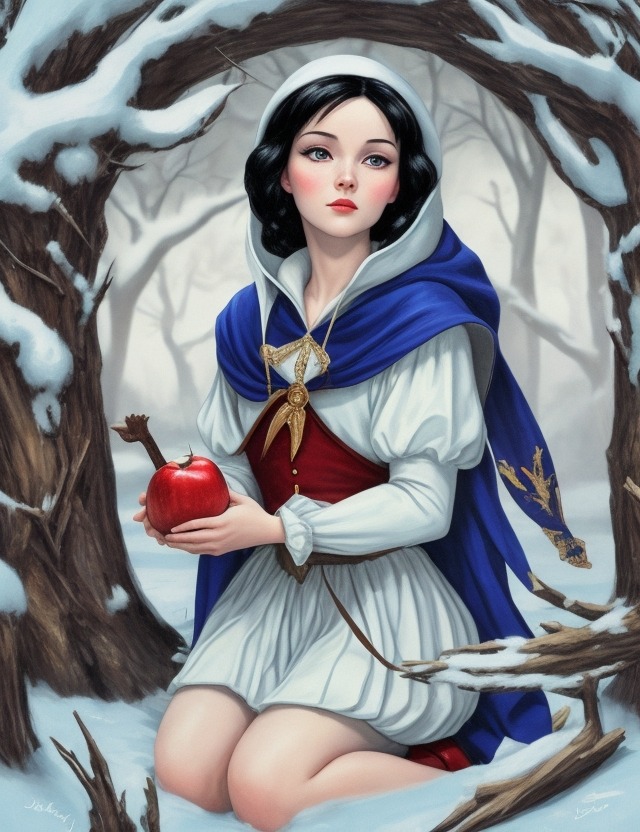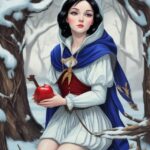Once upon a time, amidst an enchanting forest, a timeless short story fairy tale unfurled, captivating the hearts of generations. Welcome to the whimsical world of “Snow White and the Seven Dwarfs,” a classic fairy tale weaved by the renowned Brothers Grimm. This treasured story, steeped in tradition and folklore, has enticed readers and enchanted imaginations since its first publication in 1812. As we embark on this literary journey, let us delve into the depths of this enchanting narrative, shining a light on its rich history, remarkable authorship, and the unforgettable characters that have stood the test of time.
Brace yourself for a fascinating exploration that unveils the hidden depths of Snow White’s tale, leaving you eager to discover the untold secrets and profound significance lying beneath its surface. Embark on this captivating adventure, for within these pages awaits a sparkling gem of wisdom and wonder.
Summary of Snow White and the Seven Dwarfs Story
Once upon a time, in a faraway kingdom, there lived a gentle and beautiful princess named Snow White. She had lovely black hair, fair skin, and lips as red as rose. Snow White’s mother, the queen, passed away when she was just a baby, and her father, the king, remarried a lovely but wicked woman named Queen Grimhilde. Queen Grimhilde had a magic mirror, and every day she would ask it, “Mirror, mirror on the wall, who is the fairest one of all?” And the mirror would always reply, “You are the fairest, my queen.”
But as Snow White grew older, she became more beautiful than the queen. This made Queen Grimhilde furious, as she wanted to be the most beautiful in the land. One day, the mirror confessed that Snow White had now become the fairest one of all. The queen was filled with jealousy and anger. She couldn’t bear the thought of being second best.
Filled with evil intentions, Queen Grimhilde ordered a huntsman to take Snow White deep into the forest and kill her. The huntsman couldn’t bring himself to do it, so instead he left Snow White alone in the forest, hoping she would find a safe place to hide.
As Snow White wandered through the forest, the trees whispered to her and guided her towards a little cottage in a clearing. The cottage looked so inviting, but when Snow White knocked on the door, there was no answer. She cautiously opened it and discovered that the place was in disarray, as if it was abandoned. The table was cluttered with dirty dishes, and cobwebs hung from the ceiling.
Snow White tidied up the cottage and decided to rest. As she slept, the owners of the cottage returned; they were seven dwarfs who worked in the nearby diamond mines. They were named Happy, Sleepy, Sneezy, Bashful, Grumpy, Dopey, and Doc. When they saw Snow White, they were surprised and intrigued.
When Snow White woke up, she was startled to see the seven dwarfs staring at her. But after explaining her story, and how she had nowhere else to go, they all came to love her kind heart and welcomed her into their home. The dwarfs loved Snow White’s singing and happiness that filled their little cottage.
Meanwhile, Queen Grimhilde discovered from her magic mirror that Snow White was still alive. Consumed by rage, she devised a wicked plan. Queen Grimhilde was skilled in magic, and she decided to disguise herself as an old peddler woman. With a poisoned apple in hand, she made her way to the dwarfs’ cottage.
When the queen arrived, she found Snow White alone in the cottage. Snow White had been warned by the dwarfs never to let anyone inside while they were gone. But the queen’s disguise was so convincing that Snow White fell for her trickery. Queen Grimhilde handed Snow White the poisoned apple, disguised as a delicious red apple.
As soon as Snow White bit into the apple, she fell into a deep, unbreakable sleep. The dwarfs returned home and saw Snow White lying motionless. They were devastated and wept over her lifeless body. But they didn’t want to bury her; instead, they placed her in a glass coffin on a hilltop, where they could still see her beautiful face.
Time passed, and one day, a handsome prince rode by the glass coffin. He was captivated by Snow White’s beauty and leaned down to kiss her. This act of true love broke the evil spell, and Snow White awakened from her slumber. The prince and Snow White fell deeply in love and soon got married in a grand royal wedding.
When Queen Grimhilde heard of Snow White’s revival and the magical love that broke the spell, her jealousy knew no bounds. Filled with envy and rage, she attended the wedding in disguise. But her evil intentions were revealed, and she met her just punishment.
Snow White and the prince lived happily ever after, ruling the kingdom with love and kindness. The dwarfs continued to be their loyal friends, visiting the castle and sharing in their joy. The tale of Snow White’s beauty, bravery, and triumph over wickedness became legendary, reminding us all that true beauty lies not only in our appearance but also in our hearts.
Snow White and the Seven Dwarfs: Key Themes
The book of “Snow White and the Seven Dwarfs” is a beloved fairy tale that has been retold and adapted numerous times. It was first popularized by the Brothers Grimm in their collection of folk tales. This classic story explores several key themes that continue to captivate readers and audiences of all ages.
- Beauty and Jealousy: One of the central themes in “Snow White and the Seven Dwarfs” is the concept of beauty and the destructive power of jealousy. The evil Queen, driven by her own vanity, becomes consumed by jealousy when her magical mirror declares Snow White to be the fairest in the land. This theme highlights the dangerous consequences of allowing envy to control one’s actions, as the Queen’s obsession with beauty ultimately leads to her downfall.
- Goodness and Innocence: Snow White, with her pure heart, gentle nature, and unwavering kindness, embodies the theme of goodness and innocence. Despite facing various challenges and dangers, she remains untainted by the darkness around her. Snow White’s ability to see the best in others and to maintain her compassionate spirit showcases the power of goodness in overcoming adversity.
- Redemption and True Love: The theme of redemption and true love is also prominent in this story. Despite the Queen’s attempts to harm her, Snow White finds refuge and friendship with the seven dwarfs. Through her connection with the dwarfs, she is able to build genuine relationships based on mutual trust and care. Additionally, Snow White’s encounter with the Prince represents the idea of true love’s power to conquer evil and bring about redemption.
Overall, “Snow White and the Seven Dwarfs” explores themes of beauty and jealousy, goodness and innocence, and redemption and true love. Through the trials and triumphs of Snow White, readers are reminded of the importance of inner beauty, the strength of kindness, and the transformative power of love.
Snow White 7 Dwarfs Characters Description
- Snow White: The beautiful and kind princess with skin as fair as snow and lips as red as rose petals. Snow White captures the hearts of all with her innocence and gentle nature. Despite her wicked stepmother’s jealousy, she remains resilient and befriends the seven dwarfs in their cozy cottage in the woods. Always seen wearing a vibrant blue dress, Snow White’s singing voice is said to be so mesmerizing that it can even summon woodland creatures to her side.
- Doc: The self-appointed leader of the seven dwarfs, Doc is a wise and scholarly figure with a long, white beard and spectacles perched on his nose. Sporting a red hat and a green vest, this intellectual dwarf often stumbles over his words, leading to hilarious and endearing mix-ups. Although his knowledge is wide, his clumsiness tends to get the best of him, shedding light on the importance of laughter and humility.
- Grumpy: The gruffest of the seven dwarfs, Grumpy is known for his scruffy beard, furrowed brow, and tendency to scowl at almost everything. Armed with a unique sense of humor wrapped in sarcasm, he often finds himself snarling or rolling his eyes. However, underneath his tough exterior lies a heart of gold, as he eventually warms up to Snow White and becomes a fiercely loyal friend.
- Happy: With a constant smile plastered on his face, Happy brings joy wherever he goes. This jubilant dwarf is distinguished by his infectious laughter and twinkling eyes. Always dressed in bright yellow, he loves cracking jokes and funny one-liners that can turn even the gloomiest of situations into ones filled with laughter and light.
- Sleepy: A dwarf whose name says it all, Sleepy is often seen yawning and rubbing his eyes, with tousled hair and wearing a nightcap even during the daytime. Sleepy’s drowsiness knows no bounds, as he is easily lulled to sleep even during the most thrilling moments. Though he may seem lazy or absent-minded, his ability to find happiness in the simplest of things reminds us to appreciate the beauty of slowing down in a fast-paced world.
- Bashful: This shy and bashful dwarf is perpetually blushing and hiding behind his long, curly beard at any sign of attention. Bashful’s open-heartedness shines through his unassuming actions and soft-spoken nature. Often found wearing glasses and a pink tunic, he is the epitome of modesty and gentleness, reminding us of the strength found in vulnerability.
- Sneezy: With his red, runny nose and constant sneezing fits, Sneezy is hard to miss. It seems that everywhere he goes, his sneezes create whirlwinds of pollen. Despite his uncontrollable sniffles and sneezes, Sneezy’s kind heart and willingness to help others make him a valuable member of the group. Always carrying a handkerchief, he shows us the importance of embracing our quirks and learning to laugh at ourselves.
- Dopey: The youngest and most endearing of the group, Dopey is characterized by his wide-eyed innocence and playful antics. With big ears, a constantly gaping mouth, and a bright green hat, he is often the source of comic relief. Lacking the ability to speak, Dopey communicates through gestures and exaggerated facial expressions, effortlessly melting hearts with his childlike wonder and pure-heartedness.
Snow White and the Seven Dwarfs: Symbols
- The Apple: The apple is the most prominent and significant symbol in “Snow White and the Seven Dwarfs.” It represents temptation and danger. When the Evil Queen disguises herself as an old woman and offers Snow White a poisoned apple, it symbolizes deceit and the corrupting influence of envy and vanity. The bright red color of the apple also adds to its symbolic meaning, representing lust, passion, and the allure of physical beauty.
- The Magic Mirror: The magic mirror serves as a symbol of the Evil Queen’s obsession with beauty and her desire to be the fairest in the land. It reflects her inner insecurities and her need for external validation. The mirror also represents a distorted sense of self-worth, as the Queen becomes consumed by her appearance and resorts to evil means to maintain her position. The mirror acts as a warning about the dangers of being captivated by surface-level beauty and the negative consequences of vanity.
- The Glass Coffin: When Snow White is put into a glass coffin by the dwarfs, it becomes a symbol of purity, innocence, and preservation. The glass coffin represents a state of suspended animation or being frozen in time. This symbolizes Snow White’s eternal youth and beauty, as well as her untouched innocence. The glass coffin can also be seen as a metaphor for Snow White’s vulnerability, as she remains trapped and waiting for a prince to rescue her. Overall, the glass coffin serves as a powerful symbol of purity and the consequences of seeking external salvation.
Moral Lesson of Snow White
The moral lesson of Snow White and the Seven Dwarfs is to not be vain and be content with what you have. The story teaches children many lessons, including the danger of vanity. The evil queen wants Snow White dead because she cannot accept the fact that she is not the most beautiful woman in the kingdom. But it is this vanity that destroys her in the end.
Snow White and the Seven Dwarfs: Culture Impact
Snow White and the Seven Dwarfs, the beloved fairy tale written by the Brothers Grimm, has had a profound and lasting impact on global culture. Since its initial publication in 1812, this enchanting tale has captivated millions of people worldwide, transcending generations and cultural boundaries.
Historically, Snow White and the Seven Dwarfs played a crucial role in establishing the foundation of the modern fairy tale genre. It was one of the earliest notable literary works aimed at entertaining children and promoting moral values. The success of this book sparked a wave of other fairy tales, inspiring renowned authors like Hans Christian Andersen and establishing the enduring and influential tradition of storytelling.
Beyond its historical significance, Snow White and the Seven Dwarfs has carved a special place in popular culture by introducing memorable characters and enchanting storylines. The tale of the beautiful princess Snow White and her encounter with the seven lovable dwarfs captured the hearts of millions. The dwarfs themselves, with their distinct personalities such as Grumpy, Sleepy, and Doc, have become iconic figures that have been referenced, imitated, and adored in various forms of media.
One notable achievement of Snow White and the Seven Dwarfs was its successful adaptation into a groundbreaking animated feature film. Released by Walt Disney in 1937, the movie marked a significant milestone in the animation industry. It was the first full-length cel-animated feature film, captivating audiences with its vibrant colors, memorable songs, and unforgettable characters. Snow White and the Seven Dwarfs not only revolutionized animation but also paved the way for subsequent Disney classics, leaving an indelible mark on the film industry and popular culture as a whole.
The impact of Snow White and the Seven Dwarfs extends beyond its storytelling and animation. The book’s enduring popularity has influenced numerous adaptations, from stage plays to television series, ensuring that new generations continue to experience the timeless magic of this fairy tale. Moreover, the story of Snow White has become a source of inspiration for countless artists, musicians, and fashion designers, who have reimagined its themes and aesthetics in their respective works.
Lastly, this book’s cultural impact can also be found in the countless parodies and reinterpretations that it has spawned. From comedic retellings to subversive twists, Snow White and the Seven Dwarfs has provided rich material for humor and satire. Its influence has sparked creative responses that continue to entertain and engage audiences in unexpected and amusing ways.
In conclusion, Snow White and the Seven Dwarfs has left an indelible mark on global culture. Through its historic significance, iconic characters, groundbreaking adaptation into film, and ongoing inspiration for art and humor, this enchanting tale continues to captivate and inspire people of all ages, ensuring its place as one of the most beloved and influential stories ever told.
FAQs
1. Who is the author of “Snow White and the Seven Dwarfs”?
The famous fairy tale “Snow White and the Seven Dwarfs” was first published by the Brothers Grimm, Jacob and Wilhelm Grimm, in 1812.
2. How many dwarfs are there in “Snow White and the Seven Dwarfs”?
Despite the title, there are actually seven dwarfs mentioned in the story: Doc, Grumpy, Happy, Sleepy, Bashful, Sneezy, and Dopey.
3. What is the main plot of “Snow White and the Seven Dwarfs”?
The story revolves around a young princess named Snow White who is forced to flee after her evil stepmother, the Queen, becomes jealous of her beauty. Snow White finds refuge in the forest with the seven dwarfs and is eventually awakened from a deep sleep by a prince’s kiss.
4. Is “Snow White and the Seven Dwarfs” based on a true story?
No, “Snow White and the Seven Dwarfs” is a fictional fairy tale that has been passed down through generations. While it is not based on a true story, it has become a classic and beloved tale.
5. Are there any adaptations or films based on “Snow White and the Seven Dwarfs”?
Yes, one of the most well-known adaptations of “Snow White and the Seven Dwarfs” is the animated film released by Disney in 1937. This animated adaptation popularized the story and its characters and remains beloved by audiences of all ages.
6. When was Snow White and the Seven Dwarfs made?
Snow White and the Seven Dwarfs was first released in 1937.
7. Is the Snow White movie scheduled for release in 2024 cancelled?
As of August 2023, there is no official announcement that the Snow White movie scheduled for release in 2024 has been cancelled. However, there have been reports of controversy surrounding the movie’s marketing campaigns and identity politics.
8. Where does Snow White take place?
Snow White takes place in Germany, as the story was published in a collection of folktales by the Brothers Grimm, who were German.
9. When did Snow White and the Seven Dwarfs come out in color?
Snow White and the Seven Dwarfs was the first Disney film to be colorized in Technicolor, released in 1937.
10. How long was Snow White asleep?
In the original fairy tale, Snow White was asleep for 100 years.
11. How many Snow White movies are there?
There are several Snow White movies, including the original 1937 animated film, Snow White and the Huntsman (2012), Mirror Mirror (2012), and Red Shoes and the Seven Dwarfs (2019).
12. Can Snow White talk to animals?
Yes, Snow White can communicate with animals in the original fairy tale and in the 1937 animated film.
13. When did Snow White and the Seven Dwarfs come out?
Snow White and the Seven Dwarfs was first released in 1937.
14. What is the name of the evil queen in Snow White?
The evil queen’s name in Snow White is not mentioned in the original fairy tale or the 1937 animated film.










